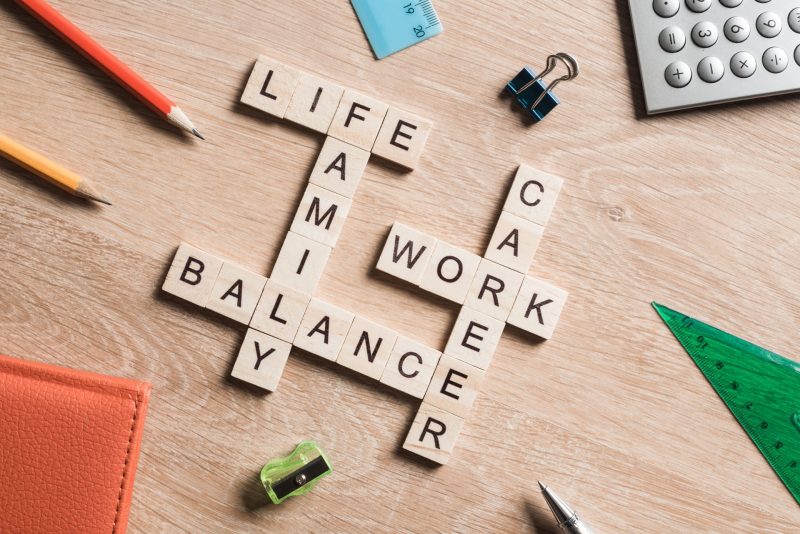

Feeling like all you do is work? You’re not alone. Several statistics show that more than 60 percent of U.S. employees feel like their work-life balance is out of whack. But how do you balance your work-life with so much work happening at home? And isn’t it good to work harder? With so many struggling to adjust to a changing, post-pandemic workday, figuring out work-home balance has gotten even trickier.
What does work-life balance mean?
We often think about work-life balance as the trade-off between time spent at work and time spent on other, non-work activities. In an ideal world, this line of thinking goes, after work, we’re able to do things that nourish us as people — whether that’s spending time with friends, family, or engaging in a hobby.
This idea of “balance” is easy enough to explain, but what does it actually mean? Is it more than just hitting a weekly yoga class? And, most importantly, in a world where the boundaries between work and home are increasingly blurred, how do you figure out what works?
Why is work-life balance essential?

Just like in our diets, to stay healthy and energized for the long-haul, people need variety in how they spend their time. We tend to fall into the trap of believing that we can be productive all the time, or that an eight-hour day at work equates to eight hours of output. However, that’s simply not true. Research shows that beyond a certain number of hours, employees actually don’t produce anything more — but the impact to their health increases dramatically.
Workaholics and those who struggle to practice self-care find themselves at higher risk for burnout, fatigue, and stress-related health issues.
Work-life balance while working remotely
One might think that working remotely would make it easier to achieve work-life balance. However, remote work presents its own challenges. Working outside of the office tends to mean multitasking, distractions, and difficulty keeping strict hours — all bad news for productivity as well as keeping work and life separate.
Prior to the coronavirus pandemic, approximately 20 percent of the U.S. workforce worked from home. Practically overnight, that number skyrocketed to nearly 70 percent. Homes became places for work, school, meals, leisure, and even working out.
There are some obvious upsides. It’s never been easier to bring your own lunch to work, rush hour is a thing of the past, and it only takes a minute to toss in a load of laundry before your next meeting.
However, engaging in multiple activities in the same space makes it harder for your brain to distinguish between work and leisure. We lack the normal cues of people leaving the office to signal when it is time to wrap up work.
When your “office” is a corner of your bedroom or your dining room table, it makes it hard to stop thinking about work when work is done — and easy to check your email just one more time. And, although we gain time back from a commute, many people miss that space and time to transition from home-life to work and work-life to home.
In an era of social distancing, our work-life balance is already struggling. For many, our work has largely adjusted to the pandemic, but many of our leisure activities and favorite outlets have not. As a result, it’s even easier to get pulled into work. We may hope that the meeting with the Marketing team will provide at least a bit of the coveted social interaction and stimulation that we’d normally get at the gym, a concert, or going out with friends.
The harmful impact of an unbalanced work-life dynamic

Poor work-life balance can have a far bigger impact than just skipping the gym. One study found that the risk of stroke is higher in people that work more than 55 hours a week. The same amount of work hours are also associated with a higher risk of anxiety and depression. And even when adjusting for fairly normal sleep patterns, another study found that working longer hours correlated with a decline in physical health.
By its very definition, work-life balance impacts all areas of your life. It tends to show up differently for different people, however. Here are 8 characteristics associated with poor balance:
1. You can’t stop thinking about work when you’re not at work. Those who find it difficult to draw boundaries between work and life are at higher risk of burnout.
2. Your relationships — both inside and outside of work — are beginning to suffer. You may be easily irritated with coworkers and distant with loved ones.
3. You feel off. You have unexplained aches and pains. You may rarely have energy or find it difficult to focus when at work.
4. When you’re not at work, everything seems uninteresting or unimportant. You just don’t feel like doing anything unless you have to. You often turn down invitations, further isolating yourself from your friends.
5. You spend a lot of money outsourcing support for personal tasks. Your laundry, dishes, and mail pile up, waiting for the day when you “have time” to get around to them.
6. You struggle to take time off when you’re sick, mentally strained, or when you need to take care of personal tasks. You don’t remember your last vacation and you don’t have plans to take one.
7. You can’t imagine doing what you do for the rest of your life. Even if you work in a field or a company you once loved, it feels impossible to imagine continuing life, as it is, for long.
8. You always feel like no matter what you’re doing, you should be doing something else. Over time, this lack of presence and direction often leads to an existential crisis.
How to achieve work-life balance

Truth is, there’s no prescription that will fit everyone. And you may have to play with what time scale feels most relevant to you. Trying to find balance in any single day may feel frustrating but the balance may be easier to achieve across a week or more. The best way to determine the best balance for you is by learning to check in with your inner compass — and your results.
With intentionality and a little creativity, you can recalibrate your expectations and reset your work-home balance.
One word of advice: start small. Although you may be anxious for your work-life balance to improve, your work habits have been built over time and likely won’t change overnight. If your goal, for example, is to reduce screen time, trying to restrict yourself to a certain number of hours will probably just frustrate you. You’re more likely to stick with a new habit if you start with a smaller target — say, one five-minute tech-free break a day.
Here are 12 tips to improve your work-life balance, with bonus tips for team leaders and managers:
1. Plan ahead to combine work activities with leisure, social, or fitness activities. If you find yourself with several virtual meetings back-to-back, try taking them while you go for a walk. You could also take a call outside (if ambient noise allows!) or invite a friend over to cowork with you.
Leaders: Set an example for your team. Take meetings while walking, introduce them to your kids on Zoom (we already know they’re there), or space out meetings so they have some breathing room.
2. Embrace the way your brain works. Use productivity hacks like a Pomodoro timer to work in short, focused bursts. Block out all other distractions so you can make the most of your time.
Leaders: Enroll yourself in Cognitive Science 101 and do a little digging into how the brain works. Schedule meetings and deadlines in ways that are digestible and attainable.
3. Set blocks of time for different tasks. Have a time where you check (and respond to) messages, a time when you take meetings, and time to do mentally-intensive work. It helps to anchor these tasks around the times that you are personally more productive.
Leaders: Try not to normalize an “instant messaging” culture. Make it clear that messages sent on off-hours don’t require immediate attention, and avoid interpreting responsiveness as engagement.
4. End work at a certain time. There’s a saying that “work expands to fill the time allotted,” and when you work from home it’s even easier to let work spill over into personal time. Set a time to end work for the day, and reinforce it by powering down work-related devices, locking your office, or scheduling something afterward.
Leaders: Don’t schedule meetings before or after work hours. This can be tricky when working across different time zones. Encourage your employees to end work at a designated time each day, and check in with anyone you notice consistently working after-hours.
5. Enlist technology to help you unplug. Use an app to block distracting websites during the day, and then block work tools after-hours. If you can, restrict work to one device, or try to keep one work-free device so you can disconnect completely.
Leaders: Encourage your team to leave their laptops and work phones at home when they go on vacation. You may think it doesn’t need to be said, but they will appreciate the explicit permission.
6. Go out for lunch, or enjoy lunch with coworkers. Even if you’re working from home, you can go out for your lunch break or connect with colleagues. The change of pace will be refreshing — and, of course, will remind you to actually eat something.
Leaders: Organize virtual happy hours, birthday parties, book clubs, and other opportunities to connect socially. Put your lunch break on your calendar so they can see that you eat, too.
7. Take time off. When you’re home all the time, you tend to try to work through illnesses that certainly would have kept you home from the office. Time off, including sick time, personal time, vacations, and bereavement, are important ways to nourish your wellbeing.
Leaders: Remind your employees that sick leave and PTO are part of their compensation, and don’t forget to take advantage of them yourself! When it comes to taking time off, actions speak louder than words.
8. Mindfulness makes imbalance hard to ignore. When you practice mindfulness techniques, like meditation or breath awareness, you become more in-tune with your emotions and physical sensations. Paying attention to these feelings helps you learn how to notice when you might be suppressing a need in order to work. It’s hard to return to that spreadsheet after you notice your stomach rumbling.
9. Find something you love outside of work to engage in. If you have something that you’re excited about doing after work, it will make it easier to disconnect from work messages or end your day at a predetermined time. Our hobbies boost our energy and vitality. When we play and feel creative, we bring our fresh selves back to work.
10. Reconsider work that makes you yearn for balance. If your work feels completely unrelated to the activities that stir your interest, enthusiasm, energy, and sense of meaning, you may need to look at how you can change the work you do or the way you do it. While work doesn’t need to (and can’t) satisfy all of your needs for purpose, meaning, social connection, and challenge, we can expect work to provide moments of satisfaction, accomplishment, and connection.
11. Communicate with your manager. Poor work-life balance is often exacerbated by the fear that we’re not doing enough. Talking to your leaders can help you prioritize where to spend your time. If there really is too much to do, it might be time to talk about hiring additional help or streamlining certain tasks.
Leaders: Make time during your check-ins to ask about employee wellbeing. You may have to read between the lines for what’s not being said. Missed deadlines or a lack of responsiveness can indicate overwhelm.
12. Work with a coach or therapist. If you feel overwhelmed, stuck, or don’t know where to begin to disconnect, working with a professional can be invaluable. A coach or counselor can help you identify which changes will make the biggest impact and how to get started.









You must be logged in to post a comment Login